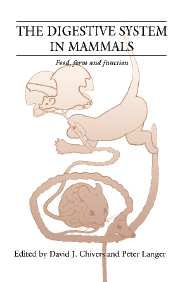Book contents
- Frontmatter
- Contents
- List of contributors
- Preface
- Part I Introduction
- Part II Food
- Part III Form
- 12 The form of selected regions of the gastro-intestinal tract
- 13 Categorisation of food items relevant to oral processing
- 14 A direct method for measurement of gross surface area of mammalian gastro-intestinal tracts
- 15 Morphometric methods for determining surface enlargement at the microscopic level in the large intestine and their application
- 16 Weaning time and bypass structures in the forestomachs of Marsupialia and Eutheria
- 17 Adaptations in the large intestine allowing small animals to eat fibrous foods
- Part IV Function
- Part V Synthesis and perspectives
- Index
15 - Morphometric methods for determining surface enlargement at the microscopic level in the large intestine and their application
Published online by Cambridge University Press: 18 March 2010
- Frontmatter
- Contents
- List of contributors
- Preface
- Part I Introduction
- Part II Food
- Part III Form
- 12 The form of selected regions of the gastro-intestinal tract
- 13 Categorisation of food items relevant to oral processing
- 14 A direct method for measurement of gross surface area of mammalian gastro-intestinal tracts
- 15 Morphometric methods for determining surface enlargement at the microscopic level in the large intestine and their application
- 16 Weaning time and bypass structures in the forestomachs of Marsupialia and Eutheria
- 17 Adaptations in the large intestine allowing small animals to eat fibrous foods
- Part IV Function
- Part V Synthesis and perspectives
- Index
Summary
The fact that animals react differently to experimental treatment (biological variability) necessitates numerical security when evaluating the effect of the treatment. If all animals reacted identically only one animal would be needed to measure the effect of a treatment. To state this differently, variability is the noise in a computer system, whilst the effect is the signal. Due to the inherent noise of the biological system, the mean signal can only be identified when the signal is made strong enough to be detected. Alternatively, by reducing the noise the effect also becomes clearer. Strengthening the signal can be attained by repetition of the experiment on different animals. Reducing the noise is achieved by use of statistical methodology. Obviously, the idea is to arrive at a favourable relationship between signal and noise.
In morphology, there is not necessarily an effect in the causal experimental sense. However, as an example, when considering the effect of different foodstuffs on an organism in an ambient environment or attempting to determine the adaptability of the intestinal tract to different dietary situations one is most certainly interested in a repetition of the signal on the test object. Obviously, more than one animal has to be observed. This statement would have been more than obvious in the early 1970s. However, in today's scientific world of government control and strict regimentation for the conservation of animals, this aspect can no longer be taken lightly. It goes without saying that the conservation of the species and rigid control of animal experimentation in those places where it is sorely needed merits not only acknowledgement but also recognition.
- Type
- Chapter
- Information
- The Digestive System in MammalsFood Form and Function, pp. 234 - 263Publisher: Cambridge University PressPrint publication year: 1994
- 4
- Cited by



